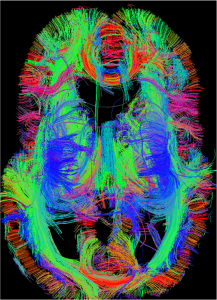
Researchers are seeking to track the brain at earlier and earlier ages (here, the brain of a newborn baby born 10 weeks prematurely). © FNNDSC 2011
For the third year running, my daughter is participating in a dyslexia study she entered at age 5, just after finishing preschool. Thinking she was part of a game, she spent about 45 minutes lying still in a rocket ship (in reality, an MRI scanner), doing mental tasks she believed would help lost aliens find their way back to their planet.
All the while, her brain was being imaged, helping a team led by Nadine Gaab of Children’s Laboratories of Cognitive Neuroscience to find a pattern indicating that she might be at risk for dyslexia. Such signatures might flag children who could benefit from early intervention, sparing them the frustration of struggling with dyslexia once in school.
Getting brain MRIs from young children – without resorting to sedation — is a difficult feat (Gaab and colleagues shared their protocol in the Journal of Visualized Experiments). But as reported in today’s Boston Globe, Gaab and Children’s neuroradiologist Ellen Grant are pushing the envelope even further, trying to find MRI signatures of dyslexia in infants.
“We know many important pediatric disorders start to emerge early on, and some things, for example dyslexia, you might not pick up until they’re reading,” Grant told the Globe. “But you know their brain has probably started to diverge from normal in some way early on.”
Even elaborate games can’t make infants hold still in an MRI scanner, so their mothers are helping soothe them to sleep, not always an easy task to accomplish for the sake of science. But Grant is leading an effort that could allow infants to be studied while awake, through hardware and software that includes motion-correction algorithms.
With other new tools, described in this video we posted previously, Grant and collaborators will be able to track the growth of individual brain structures, and detect problems in brain organization before anything can be noticed by parents or physicians — not just in dyslexia but in other developmental disorders, like
autism and ADHD.
Autism responds well to early intervention – indeed, it’s the only real “treatment” — but is difficult to diagnose before age 12 to 18 months. In parallel with Gaab’s work, Charles Nelson, research director of Children’s Division of Developmental Medicine, is comparing brain electrical activity and eye movements in infants at high risk for autism—having at least one older sibling on the autism spectrum—versus controls with no such family history, seeking an early indicator.
One early result suggests that EEG signals indicate something amiss in brain function and structure at as young 9 months of age: EEG s had 80 percent accuracy in distinguishing those in the high-risk group (with affected siblings) from the controls. Nelson’s co-investigator, computer scientist Bill Bosl, envisions cheap headsets in every pediatrician’s office, borrowed from gaming technology, that could be used to check cognitive growth at well-child visits.
Grant is going back even earlier in development, imaging newborns born prematurely to detect early problems with brain folding, wiring and oxygen consumption. Working closely with clinicians, she hopes the imaging modalities she’s developing can guide therapies for newborn brain injury at the bedside and evaluate the effects of treatments. “Our goal is to optimize the neurologic function of every child coming through Children’s,” she says.







